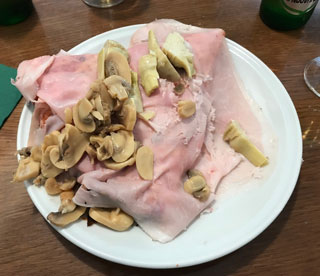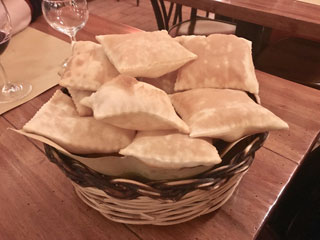
Vol. XVIII, No. 2, February-March 2018
- Randy's travelogue - journey to Milan, Italy & FICO Eataly World
- When something goes wrong, apologize, apologize, apologize to the customer: WRONG!
- Doc Brundy's sodacad under construction
- Changes to the leisure time landscape and its impact on out-of-home entertainment and arts
- Restaurant campers
- It's a beautiful Saturday
- iGen and Clean Lifers partying, drinking & hanging out less
- The six laws of customer experience
- Fighting for out-of-home entertainment participation & spending
- Clean restrooms means more revenues and profit
- Short introduction to Urban Neuroscience
- The future ain't what it used to be
Randy's travelogue - journey to Milan, Italy & FICO Eataly World
In late January, early February I had the pleasure to travel to Milan, Italy. Despite my extensive international travels over the past decades, I had never been to Italy. So this was my first and it ruined me for my future dining preferences in the U.S. After eating authentic Italian cuisine, I'm never going to be able to eat in an American Italian restaurant, as none I've every eaten at even comes close. In fact, American Italian cuisine is completely different from the real authentic Italian food. Only once did one of my entrees involve tomatoes. And I was advised only a limited number of Italian recipes actually include garlic - it is not a universal ingredient like it seems to be in the U.S.

My trip had two purposes - one to visit FICO Eataly World, the new food theme park that had just opened, and two to visit Enrico Banchi. I first knew Enrico twenty-some years ago when our company developed Dinotropolis, a 50,000-square-foot children's entertainment center in Caracas, Venezuela.
Back then Caracas was a thriving metropolis (its really sad what terrible condition the city and country are in today). Enrico was the project manager and then the general manager for Dinotropolis.
When we worked there, we were driven around by our client's security force, which I called their army. They would sit in the front seat with guns on their laps and we would sit in the back seat. Just about everyone in Caracas carried a sidearm. The problem was kidnappings for money and our clients were wealthy, so they were prime targets.
At Dinotropolis, we decided with so many people carrying guns, it wouldn't be good for business to have a shootout in the center, so we had gun check lockers and metal detectors at the entrance. Back then, when I explained this at IAAPA and other convention presentations, the audience was shocked. Now, considering the current times in the U.S., that doesn't seem like such a bad practice.
So a number of years later in 2001, I received an email from Enrico saying he had just moved back to his home country of Italy as Claudette, his wife, had just been kidnapped for the second time.
When they moved back, they had to leave everything behind in Venezuela and came to Italy with only $50,000. After a few years of struggle, Enrico started a new career and is now a highly successful and renowned consultant, executive coach and international keynote speaker and a partner of Scuola di Palo Alto in Milan.
Enrico is an expert on the differences in the functioning of the female and male brains, how it affects relationships in business and private life, how to improve customer experiences and he teaches women how to build and develop positive management styles capitalizing on their innate characteristics and strengths. We're pleased to feature two articles by Enrico in this issue, It's a beautiful Saturday and Introduction to Urban Neuroscience. Enrico is looking for opportunities to share his knowledge and expertise with American businesses. I sat through one of his lectures. He's a very dynamic, engaging and effective speaker.

While in Milan, Enrico took me to a number of excellent Italian restaurants. In fact they're all excellent in Italy, at least the ones the residents go to, as the bar for food is so high there, that if a restaurant isn't excellent, it won't survive for long. Among the many eating experiences (yes, eating at a restaurant in Italy can definitely be classified as an experience, and a good one at that), we had lunch one day at Pizzeria di Porta Garibaldi. There I had Italian pizza like no pizza I've ever had. The thick, light, fluffy texture crust, more like thick soft bread, is covered with meats. I added mushrooms to mine.
On my last night there Enrico, Claudette and I dined at Osteria del Gnocco Fritto, right down the street from my hotel, the Art Hotel Navigli and Enrico's office, in the popular artsy, antique, historic and nightlife Navigli district named after the Naviglio Grande canal, constructed in 1179-1209, that goes through it. Leonardo Da Vinci constructed its dams.

Navigli district of Milan, Italy

Osteria del Gnocco Fritto specializes in serving gnocco fritto with a choice of 32 different cold sliced meats and 20 different cheeses. Gnocco fritto is Italian bread from the Emilia region of Italy not far south from Milan that puffs up when fried. The gnocco fritto is served in a wicker basket and constantly replaced to assure it is always warm fresh from the oven. The quality and flavors of the cheeses and meats were to die for. Paired with the warm gnocco fritto, it's more than enough justification to make a trip to Milan singularly to just experience it.
While in Milan, I also visited one of Eataly's original foodertainment stores. It's similar in concept to the Eataly stores in the U.S. (Chicago, New York, LA and Boston and new ones coming to Las Vegas and San Francisco), but not as spacious in its layout and has more floor levels.

Eataly, Milano, Italy
Fico Eataly World
One day Enrico and I drove a little over 2-hours southeast to the city of Bologna to visit FICO Eataly World that opened just a few months earlier in November. FICO - meaning “fig” and slang for “cool” in Italian - technically stands for Fabbrica Italiana Contadina (Italian Farming Factory). Everyone in Italy calls the park FICO rather than Eataly World.
It's a little hard to describe it as it's a new destination venue category. In a sense it's a food theme park, sans any theme park rides. Unlike theme parks, FICO is free to enter. It's a food hall on steroids that not only has a wide selection of food and beverages to dine on and purchase, but also has food production facilities were you can see all types of Italian foods being made and all types of food and wine demonstrations and classes. Eataly World describes itself as the largest agri-food park in the world, telling the story of Italian agri-food culture. It is a foodie heaven that celebrates all types of Italian food culture.
At a cost of 147 million dollars, Eataly World covers 25 acres and includes a 700,000+ square foot building that houses 45 Italian trattorias, restaurants, eateries and street-food kiosks. Most of their kitchens and the food factories are visible behind glass. They host 30 daily sessions on food production. There are pop-up-style stores selling Italian produce, foods and kitchenware; classrooms; sports and play areas; a cinema and a 1,000 person function space. Outdoors there are farm animals and vegetable plots.









There are technically six rides, educational ones called carousels, which chart humans' relationship with agriculture. Functionally they are more like museum experiences that you walk through than actual carnival-type rides (watch short video that shows them).

I enjoyed my visit to FICO. Enrico and I ended up renting the tricycles to get around, as otherwise you could easily wear yourself out with all the walking. We ended up spending a little over 4 hours there. A visit could easily take a full day if you took any of the tours and classes and watched some of the demonstrations, all in addition to enjoying some of the best food, coffee and wines from all over Italy.
I especially liked the design of the main hall. Intentionally or not, its roof-ceiling and architectural design gave it great acoustics. It didn't have the typical cavernous reverberant acoustics like many large halls that can make it difficult to hold a conversation, which research has shown will induce physiological stress, not conducive to creating a long length-of-stay at a destination venue.
Although FICO Eataly World is a celebration of the similar food cultures from just one country, I could see how a similar concept could work in other countries, even the U.S., where the food cultures of different regions vary so much. I think a challenge for FICO in Italy will be how many Italians versus tourists it will attract, as Italians have so many of the cuisine opportunities in their own back yards.
Other activities
In February, I presented Positioning food & beverage to increase profits at the North American Farmers Direct Marketing (NAFDMA) convention in LA. That's the organization that represents the agritainment and agritourism farms in North America. And this month, my guest essay, Cocooning is the New Going Out. Consumer Habits Already Affecting the Future - Part Two, was published in Replay Magazine. You can read the article by clicking here.
We have a lot of projects underway including one involving skateboards, we're working for two different Indian Nations on development of eatertainment concepts that incorporate bowling, including two at casinos and one freestanding We are also working on adding a leisure center to a 5-star resort, and continuing our 24-year consulting relationship with Davis Farmland and Mega Farm Festival in Massachusetts. Two of our projects, Doc Brundy's and Ocean5 and its Table 47 destination restaurant will be opening soon (you can read about Doc Brundy's in this issue).
We have lots of great stuff to read in this issue. Enjoy!

Vol. XVIII, No. 2, February-March 2018
- Randy's travelogue - journey to Milan, Italy & FICO Eataly World
- When something goes wrong, apologize, apologize, apologize to the customer: WRONG!
- Doc Brundy's sodacad under construction
- Changes to the leisure time landscape and its impact on out-of-home entertainment and arts
- Restaurant campers
- It's a beautiful Saturday
- iGen and Clean Lifers partying, drinking & hanging out less
- The six laws of customer experience
- Fighting for out-of-home entertainment participation & spending
- Clean restrooms means more revenues and profit
- Short introduction to Urban Neuroscience
- The future ain't what it used to be


